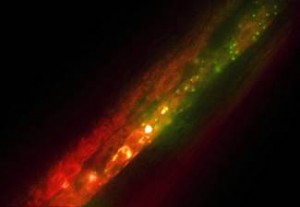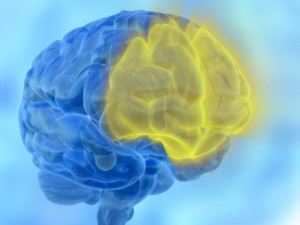By Natalie Banacos
Black Swans and Tiger Moms

I am surprising myself this week by delving into the more psychological and less biological side of neuroscience. Upon seeing the haunting Black Swan over winter break, I was immediately intrigued by its psychological underpinnings. Not long afterward, a friend showed me a fitting article from the Wall Street Journal titled, “Why Chinese Mothers are Superior” by Amy Chua. As it turns out, Chua’s article is an excerpt from her highly controversial book on parenting, Battle Hymn of the Tiger Mother. In her book, she describes to the Western public her use of persistence, force, and even verbal attack to get her children to be their best. Although shocked at some of the details, I found some of Chua’s arguments compelling. But how far is too far? Can we be driven insane by a desire to achieve, like the unfortunate protagonist in Black Swan? Or do the hours at the piano and the endless repetition of multiplication facts pay off in the end?
Nina, played by Natalie Portman, is the main character of Black Swan, a ballet dancer whose life seems to revolve around two places: the dance studio and the apartment she shares with her overbearing mother. The mother, we learn, was a dancer when she was younger and is channeling her unfulfilled ambitions into Nina, who she desperately wants to see take the lead in Swan Lake. Roger Ebert describes this tiger mom in his review of Black Swan as “a mother whose love is real, whose shortcomings are not signaled, whose perfectionism has all been focused on the creation of her daughter.” The daughter becomes so focused on perfecting her art, trying to please her mother and her ballet company director that the rest of her life unravels along with her concept of reality itself.
 Of course, for the number of hard-driving parents out there, I’m sure there are significantly fewer Ninas: people driven to insanity by their need for perfection. Still, Black Swan makes viewers cringe at the thought of putting someone through such a rigorous practice regimen and limited schedule as hers. In the same vein, Amy Chua’s book has received much backlash, as exhibited on the Today Show where the host read viewer comments on Chua’s approach deeming it “outrageous” and calling Chua “a monster.” Her daughters were not allowed to have sleepovers, participate in school plays, earn any grade less than an A, watch television, and the list goes on. In addition, she relates a story about her daughter Louisa’s struggles to learn a piano piece and the tactics she used to get Louisa to succeed. Chua forbade her daughter to leave the piano even for bathroom and water breaks, threatened her, told her to be less “lazy, cowardly, self-indulgent and pathetic” – terms she considers motivational.
Of course, for the number of hard-driving parents out there, I’m sure there are significantly fewer Ninas: people driven to insanity by their need for perfection. Still, Black Swan makes viewers cringe at the thought of putting someone through such a rigorous practice regimen and limited schedule as hers. In the same vein, Amy Chua’s book has received much backlash, as exhibited on the Today Show where the host read viewer comments on Chua’s approach deeming it “outrageous” and calling Chua “a monster.” Her daughters were not allowed to have sleepovers, participate in school plays, earn any grade less than an A, watch television, and the list goes on. In addition, she relates a story about her daughter Louisa’s struggles to learn a piano piece and the tactics she used to get Louisa to succeed. Chua forbade her daughter to leave the piano even for bathroom and water breaks, threatened her, told her to be less “lazy, cowardly, self-indulgent and pathetic” – terms she considers motivational.
In contrast, studies have shown that such verbal aggression is detrimental not only to kids’ self-esteem, but to their school grades. One such study, published in Child Abuse & Neglect showed that kids with verbally aggressive parents showed poorer marks in French, their native language, especially those students who perceived themselves as verbally abused. The authors pointed out that children who are the victims of such aggression tend to doubt their scholastic ability, their behavior and their general worth. Another more recent study in NeuroImage showed a 14.1% increase in gray matter volume in the superior temporal gyrus in subjects who were exposed to parental verbal aggression. Statements like these are compelling – but the first study failed to show any decline in math skills due to verbal abuse, and the sample size was quite small in the correlational second study.
As horrifying as Chua’s method sounds, when Louisa finally mastered the piece, she didn’t want to leave the piano and was back on excellent terms with her mother that same night. Oddly, it was an exercise in self-esteem: Chua didn’t want her daughter to give up; she wanted her to understand what it’s like to succeed when you didn’t think you could. In essence, she was berating her daughter to build her confidence because she believed in Louisa’s ability to overcome laziness and fear.
It is a fact of cognitive neuroscience that practice does make perfect (see Piano Teachers Must Be Neuroscientists). In the Time article reviewing Amy Chua’s book, psychology professor Daniel Willingham agrees. He says that once you’ve mastered a physical task like a piano piece, you can perform it without thinking about it, leaving certain areas of your brain free to engage in more complex interpretation of the music you’re playing. Rather than being stifled by verbal aggression, perhaps Chua’s children now have an extra outlet for expression. They may not be perceiving themselves as verbally abused either – it seems that Chua is somehow letting her kids know that she believes in their potential.
With such talent to express themselves with, how could a kid end up like Nina the Crazy Ballerina? My guess is that driving children to succeed is not the issue: it’s instilling a fear of failure, a fear of accomplishing nothing, a fear that Chua pushed her daughters to overcome. In another article in Time article detailing the extent to which parents go to protect their young from everything, Nancy Gibbs writes, “we were so obsessed with our kids’ success that parenting turned into a form of product development,” as she discusses the overload on extracurriculars and safety devices that parents pile on to make sure their kids survive in this competitive day and age. In the article, Gibbs cites author Carl Honore, who says, “With children, they need that space not to be entertained or distracted. What boredom does is take away the noise… and leave them with space to think deeply, invent their own game, create their own distraction. It’s a useful trampoline for children to learn how to get by.” Regardless of whether or not kids can play the piano like Mozart, they tend to find a suitable creative outlet if given time. Do kids who have practiced assigned violin exercises for hours on end have time to reflect on what they are putting into their music on a more emotional level? If they’ve never had the opportunity to create as they please, as adults these people may not know how to cope with a lack of stimulation. Maybe this was the Black Swan’s problem: when presented with a role in Swan Lake that required her to branch off from her drilled-in technical ballet skills and become her character, Nina was afraid of the freedom and the possibility of failure. In my experience growing up with non-Tiger Parents (yet supplemented with Tiger Piano Teacher), it seems to me that a blend of discipline and hard work, along with time to just have fun and be a kid is the best formula for success.
Black Swan Movie Review – Roger Ebert
Tiger Moms: Is Tough Parenting Really the Answer? – Time Magazine
Why Chinese Mothers Are Superior – The Wall Street Journal
Effects of parental verbal aggression on children’s self-esteem and school marks – Child Abuse & Neglect
Exposure to Parental Verbal Aggression and Gray Matter Volume – NeuroImage
Helicopter Parents – Time Magazine
Under Pressure: Rescuing Our Children from the Culture of Hyper-Parenting – Carl Honore
Atkins for Epilepsy?
...Well, it’s not exactly Atkins, but the ketogenic (or "keto," for short) diet is now being prescribed as a treatment for drug-resistant pediatric epilepsy. This low-carb, high-fat diet involves eggs, cheese, yogurt, and cream all to a seemingly unreasonable and unhealthy extent. Patients require supplements to stay healthy and grow, and must drink enough fluids to avoid kidney stones. As crazy as it sounds, it works.
Dr. Elizabeth Thiele, a pediatric neurologist at Massachusetts General Hospital, has compiled clinical data showing 7 out of 10 patients reducing their seizure count by more than ninety percent on this diet. It appears that the diet has few lingering health effects after it is stopped and does not seem to stunt growth, and doctors have been using it since the early twentieth century. But how does fat prevent the electrical surges in brain activity that constitute epilepsy?
The current theory is that ingesting large amounts of fat forces the body to mimic starvation mode and burn fat for energy rather than carbohydrates. The ketone bodies that result from the breakdown of fats seem to have certain unique properties that help to protect the brain. All kinds of applications for these ketone bodies are being studied, including their ability to promote the slowing of tumor growth, and their potential use for the treatment of Alzheimer’s and Parkinson’s Disease. How the ketone bodies are doing this has yet to be discovered so drug development is limited. Fortunately, the studies demonstrating the effectiveness of the diet in pediatric cases is opening the door for further research funding.
Original article: Epilepsy's Big, Fat Miracle - The New York Times
Additional reading: The ketogenic diet in childhood epilepsy - where are we now? - Archives of Disease in Childhood
A Medical Molecular Mechanism
Tired of hearing about halogenation and hydrogenation reaction mechanisms? Keep that organic chemistry book open, because it gets better:
At Columbia University Medical Center, researchers have discovered the reason for the build-up of harmful proteins in Parkinson’s patients. The scientists have worked out a mechanism for the build-up of a class of proteins known as polyamines, a known neuron-killer involved in Parkinson’s disease. High-resolution fMRI scans showed a brainstem region in Parkinson’s patients that produced less activity than the same region in healthy patients. Based on tissue samples from deceased patients, Dr. Scott A. Small of Columbia posits that SAT1, an enzyme that breaks down polyamines, might play a role in the development of Parkinson’s and thus explain the differences in the fMRI studies.
Experiments in yeast, mice and humans have shown the pathogenicity of polyamines. At Brandeis University, researchers showed that yeast cells engineered to produce polyamines died more quickly than yeasts that were not. Scientists at UC San Diego School of Medicine used mice to both demonstrate the connection between SAT1, polyamines and Parkinson’s and to show that SAT1-targeting drugs could help to deter the progression of the disease. In addition, Columbia researchers have studied the SAT1 gene and found a genetic variation that is present in Parkinson’s patients but absent in healthy control subjects.
Several years ago, polyamine-lowering drugs were being studied as potential cancer treatments. It was unclear in these trials whether or not the drugs could penetrate the blood-brain barrier. The ability to penetrate the blood-brain barrier is crucial for Parkinson’s treatments: if the drug cannot get through, it must be administered into the brain directly. Dr. Small’s lab is currently working on drugs that can pass through the blood-brain barrier so that Parkinson’s can be effectively treated with pills rather than brain surgery!
Sources/Additional Readings
New Molecular Pathway Underlying Parkinson's Disease Identified - Karin Eskenazi, media contact, neurosciencenews.com
Polyamine pathway contributes to the pathogenesis of Parkinson disease - Lewandowski et al. (Original Article)
Light-Up Brains
Studying neurological disorders and identifying the brain regions associated with them often involves selective activation and deactivation of neurons. Blue light has been used in the past to activate cells, but recently Stanford University neuroscientists have figured out a way to use different colors of light to inhibit neurons. Their growing area of research, optogenetics, involves the engineering of viruses that insert genetic coding for light-sensitive proteins into cells of interest.
In the 2 April 2010 issue of Cell, Karl Deisseroth and his colleagues at Stanford published a study demonstrating the use of near-infrared wavelengths in neuron inhibition. Infrared light, being at a higher wavelength than blue light, delivers less energy to tissues and is safe at low power. Its ability to reach deeper brain regions, and thus cover more volume, is useful in in-vivo experiments. Additionally, using different colors of light to alter the activity of different brain regions at the same time could provide some answers as to how changes in various regions work in conjunction with each other to cause neurological problems. Optogenetic technology is already being used in research to study motor control, reward, addiction and other neuropsychiatric disorders.
Switching brain cells on and off using multicolored light - Marie Freebody
Molecular and Cellular Approaches for Diversifying and Extending Optogenetics - Article in Cell
Piano Teachers Must Be Neuroscientists
The familiar mantra “practice makes perfect” may be taken too literally. The definition of effective practice as the constant repetition of a particular exercise - a golf swing, a tennis serve, a dance step - is faulty, as it turns out.
Time has reported on a study published in Nature Neuroscience by neuroscientists at the University of Southern California and UCLA. The study compares the results of repetitive, “constant practice” with the results of “variable practice." In one experiment, scientists instructed a group of subjects to copy a movement with their forearm as displayed by a line on a computer screen. One group representing constant practice repeated a movement holding their arm at 60-degrees 120 times. The variable practice group was asked to do the same 60-degree movement only 60 times, but they were also asked to do three other movements 20 times each. The two groups did equally well in practice. However, when they were retested 24 hours later, the variable practice group outperformed the rote repetition group on the 60-degree task.
So, variable practice works - but why? Some of the subjects from each group were treated with transcranial magnetic stimulation (TMS). A portion of each group had TMS in the prefrontal cortex, and another portion received TMS in the primary motor cortex. The prefrontal cortex is the part of the brain that allows for executive functions like reasoning and planning while the primary motor cortex deals with simple, physical task learning. Fittingly, when the prefrontal cortices of variable-practice group members were “messed with” by TMS, the performance of the participants declined. Performance levels also decreased when constant-practice subjects underwent TMS in their primary motor cortices. It seems that “tedium is bad for the brain,” and it needs variety to actively learn by using higher structures like the prefrontal cortex to better retain what has been practiced.
It would be interesting to find out whether or not this concept applies to different types of learning, like studying for exams or playing an instrument. Even when training a dog, it is suggested to work amid distractions and to increase the time between clicking the “clicker” to let the dog know it has performed a task correctly and rewarding it with a treat. A higher level of focus seems to occur when there are more variables in the practice routine. My piano teacher must have been on to something when she gave me so much homework!
Study: Why Athletes Should Mix Sports-Training Routines - Time
Article: Practice Structure and Motor Memory -Nature Neuroscience
Use Your Brain: Lower Your Cholesterol
This month in Nature Neuroscience an article was published by the University of Cincinnati College of Medicine (Perez-Tilve et al.) detailing the effects of the neuroendocrine system on cholesterol levels. According to the article, hypercholesterolemia (high cholesterol) is difficult to treat as a whole because there isn’t much known about the molecular origin of the condition. Unfortunately, symptoms are too well known: obesity, high blood pressure, poor glucose metabolism. The research presented shows a link between high levels of the hormone ghrelin and high cholesterol.
In one portion of the study, mice given ghrelin for a week showed increases in body fat and in cholesterol, but control mice did not. Ghrelin, which makes you feel hungry, acts on a central nervous system circuit called the central melanocortin system. When mice were given melanocortin inhibitors, HDL cholesterol increased, implying that melanocortin receptors regulate HDL regardless of food eaten.
Another hormone, GLP-1, was tested in the mice. This hormone makes you feel satisfied after having eaten, so the researchers gave mice infusions of GLP-1 for a week. Their cholesterol decreased compared with the control mice - so it was concluded that gastrointestinal hormones can regulate cholesterol both positively and negatively. Additional research showed that mice that were deficient in the genes that code for GLP-1 receptors had higher cholesterol than wild-type mice.
Perhaps in the near future the use of statins to control cholesterol levels could be decreased or even eliminated. While the cardiovascular implications of high cholesterol are dangerous, so are the side-effects of the treatment. Statins, the common treatment for high cholesterol, don’t deal with the regulatory hormones; instead, they inhibit enzymes that take part in the synthesis of cholesterol. They also don’t work to reduce triglyceride levels and raise HDL levels. Although HDL is known as “good cholesterol” the study showed that rats with high HDL were susceptible to atherosclerosis and symptoms of high cholesterol. Pharmaceutical research is already being directed toward finding agonists for GLP-1 receptors and antagonists for ghrelin receptors in order to treat all of the symptoms of hypercholesterolemia.
To read the full article in Nature Neuroscience, click here:
http://www.nature.com/neuro/journal/vaop/ncurrent/full/nn.2569.html#/affil-auth

